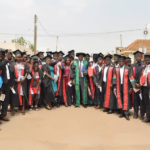Uganda Judiciary Saves Billions as New Court Buildings Near Completion

Judiciary is making significant progress in completing court buildings across the country, which will save approximately 9.973 billion shillings in rent. The Judiciary has also introduced video conferencing systems and provided vehicles to enhance security and efficiency for judicial officers. These efforts aim to improve infrastructure, technology, and resources to enhance the delivery of justice services in the country.

Dr. Pius Bigirimana has said that the completion of court buildings across the country will save the judiciary at least shillings 9.973 billion in rent, now that construction is back on course. Bigirimana, the Permanent Secretary to the Judiciary, blamed the COVID-19 pandemic for the delays in the construction of the different court buildings. He noted that the project started on December 5, 2019. It was expected the construction would be done by 2021.
He says it is still on schedule, despite some delays.
The construction of the Court of Appeal and Supreme Court buildings and other courts are nearly complete, with the Supreme Court building at 92% and the Court of Appeal building at 85% completion.
“We are hopeful that this year we will be able to enter the courts,” Dr. Bigirimana stated.
To reduce rental expenses, the Judiciary is constructing more courts.
Some have already been completed, such as the Chief Magistrates courts in Mukono, Butambala, and Mayuge, as well as the Namanyingo Justice, Kole Justice Centre, and Kamwenge Chief Magistrate court.
However, courts in Buhweju, Namayingo, and Kole are yet to be completed.
To expand their services, the Judiciary has operationalized six new high court circuits in Iganga, Tororo, Luwero, Hoima, Rukungiri, and Moroto. This brings the total number of high court circuits in Uganda to 20. Last year, the Judiciary expanded its staff by recruiting a total of 281 personnel, including 216 administrative staff. They also deployed resident Chief Magistrates, Magistrates, and confirmed 131 judicial officers and 42 staff.

Figure Judiciary Permanent Secretary, Pius Bigirimana
Regarding technology, the Judiciary has introduced video conferencing systems in courts, including the Court of Appeal and High Court Criminal Division. This move aims to minimize the transportation of prisoners, reducing costs, and minimizing the risks associated with prisoner transportation. “We have put video conferencing system we want to minimise the transportation of prisoners. This reduces on transport cost, it reduces on the risks involved, the risk of prisoners disappearing,” Pius states.
To enhance security for judicial officers, the Judiciary has provided vehicles to all judges and other personnel. This includes 65 vehicles for judicial officers and supervision, 3 for justices of the Court of Appeal, 20 for judges of the High Court, four for Registrars, 16 for Chief Magistrates, 17 for Magistrates Grade 1, 5 for field supervision, and 14 minibuses.
Furthermore, furniture will be procured for 27 courts, 12 new justices, and the Judicial Training Institute, as they currently rely on borrowing furniture from local councils to carry out their work effectively.
The Judiciary in Uganda is actively working towards improving infrastructure, technology, and resources to enhance the delivery of justice services in the country.







